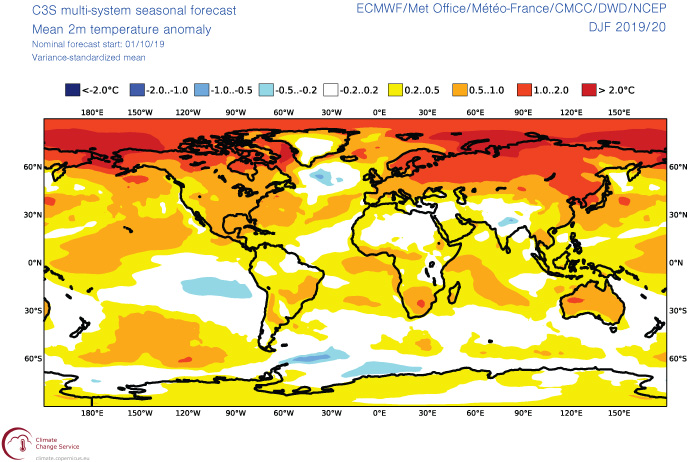

The EUROSIP multi-model seasonal forecasting system has been retired, with forecasts now being provided by the Copernicus Climate Change Service (C3S) multi-model. C3S is implemented by ECMWF on behalf of the EU.
Multi-model seasonal forecasts have been provided at ECMWF since 2005, when the EUROSIP project released its first forecasts. October 2019 is the first time since then that EUROSIP products have not been produced – EUROSIP has officially retired. The reason is simple: EUROSIP has been replaced by the much more comprehensive Copernicus Climate Change Service (C3S) multi-model system.
Why multi-model forecasts?
Seasonal forecasting is a challenging science. We can in principle use an ensemble of numerical model forecasts starting from the estimated initial conditions of ocean, atmosphere and land to calculate the probabilities of different weather outcomes in the months ahead. When we try this, we find that the probabilities calculated from any single model are not always reliable – our models are not perfect, and even small inaccuracies accumulate over the months and distort the statistics of weather. We are continually working to improve our models, but it will be many decades, if ever, before a single model can produce completely reliable forecasts.
Multi-model forecasting systems are a simple but remarkably powerful way of addressing the reliability problem. Different forecasting systems have different errors. If we combine different forecasts, the effects of some of the model-specific errors are averaged out, giving a better estimate of the most likely outcome. At the same time, the differences between models give a measure of the system-related uncertainty in the forecast. Multi-model systems are not perfect – some errors can be common to all models, for example. Nonetheless, they tend to give forecasts which are both more accurate and more reliable.

Example C3S multi-model forecast from 1 October 2019 of the ensemble mean 2-metre temperature anomaly for December 2019–February 2020.
What is the history of EUROSIP?
Multi-model seasonal forecasting was pioneered in Europe in the 2000s with two EU-funded research projects (DEMETER and ENSEMBLES). Following the first of these, ECMWF, Météo-France and the UK Met Office decided to collaborate on a multi-model seasonal forecasting system, to be run at ECMWF, with forecast production starting in 2005. NCEP then joined as an associate partner, contributing to the forecasts from 2012, and JMA joined in 2017.
EUROSIP leaves a legacy of having pioneered multi-model seasonal forecasting systems; it was followed by similar developments in Asia (the APEC Climate Centre, hosted in South Korea) and North America (the North American Multi-Model Ensemble).
Why is the C3S multi-model taking over?
The EUROSIP system was run on a voluntary basis, with limited coordination and few resources for the development of products. Data policy restrictions meant that EUROSIP could not make available the input data to users, limiting the usefulness of the system. When the European Commission developed the Copernicus Climate Change Service (C3S), good access to seasonal forecast data was considered an important priority. Resources were made available to develop an open-data multi-model seasonal forecasting service, including not only the production of forecasts but also a range of user services. It has taken time to spin-up the C3S multi-model system, so EUROSIP continued to run in parallel with it for some time. Now the C3S system has become mature enough, EUROSIP is finally being decommissioned.
What are the advantages of the C3S multi-model system?
The resources made available by C3S have allowed the inclusion of more forecasting systems, with contributions from Germany (DWD), Italy (CMCC) and, most recently, NCEP adding to the original three EUROSIP partners. The models have increased resolution and improved re-forecast datasets, and they provide a more comprehensive range of output data. A wider range of plots are available, allowing the forecasts of the individual models to be compared. The plots are released earlier than before (presently the 13th of each month, as opposed to the 15th and 22nd for Member State and public users, respectively). Most importantly, all the forecast and re-forecast data are now freely and publicly available.
What else is there to look forward to?
Data from the Canadian seasonal forecasting system will be added to the C3S multi-model system shortly, and JMA data will be added in due course. Accessibility of data within the Climate Data Store will continue to improve, and further products will continue to be made available.
